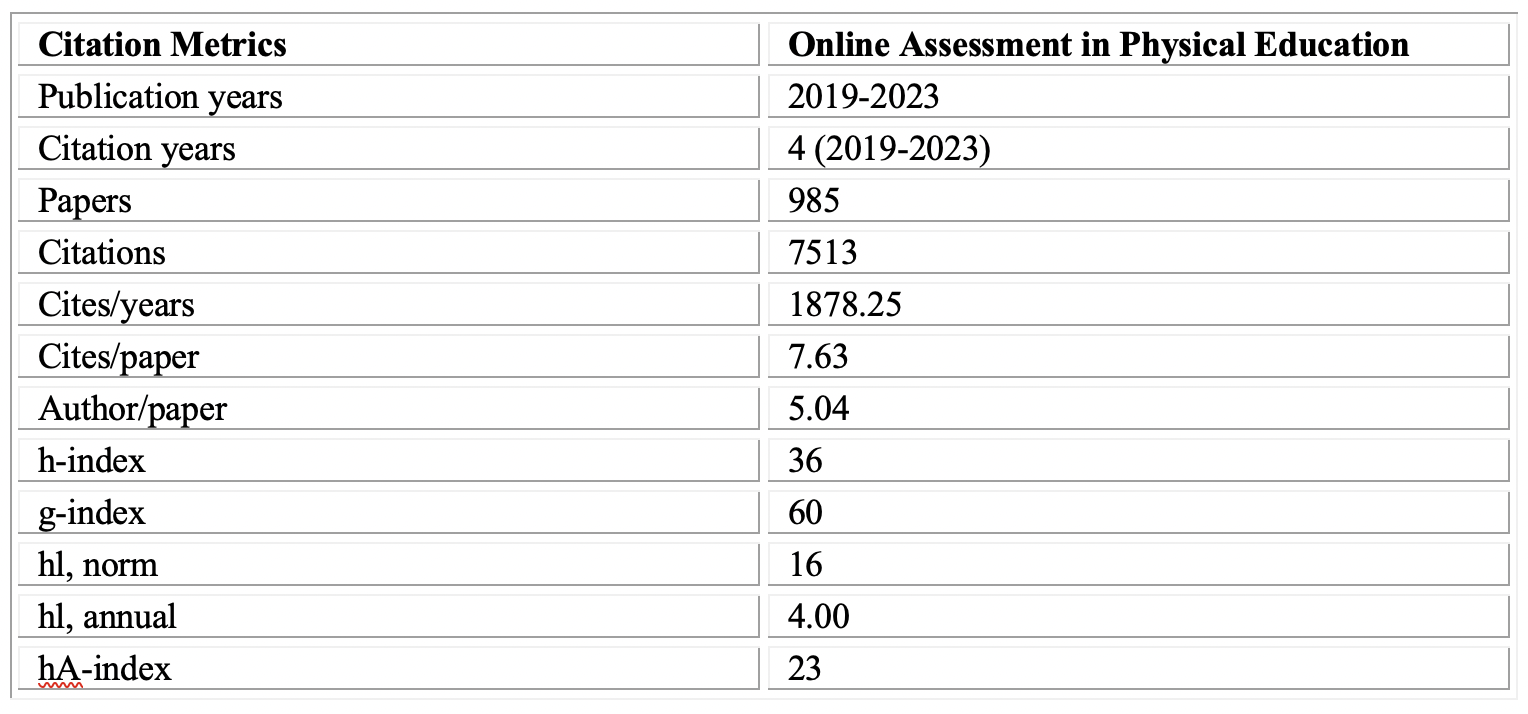
2024 VOL. 11, No. 2
Abstract: Covid-19 significantly contributed to increasing use of online assessment in education, including physical education. Teachers still need online assessments in face-to-face learning because they help them improve a practical, objective, and credible assessment process for students' learning performance. This research aimed at tracking the publication trends of OA in PE in four years, 2019-2023, from the Scopus database. The investigation began on October 11, 2023, using the title, abstract, and keywords of "online AND assessment AND in AND physical AND education," and the researchers succeeded in collecting 985 documents (articles = 82.74%, conference papers = 8.83%, reviews = 6.19%, book chapters = 1.32%, and conference reviews = 0.91%). The publication trend metrics were highest in 2021 with 277 articles (28.12%) and began to decline by 0.10% in 2022 (to 28.02%) and 9.04% in 2023 (to 18.98). Over the four years 2019-2023, there were 2698 citations from 277 documents (average citations per document = 9.74). VOSviewer analysis proves that the title words "online assessment" and "physical education" have a small item load, so the visualisation was not visible in the VOS viewer output. Apart from that, the two title words also did not have a connection. This means that this study proved the results of online assessment investigation in physical education still has potential for future research. Future research can explore and project the various needs for developing OA in PE to help teachers organise effective, efficient and credible assessment activities.
Keywords: online assessment, electronic assessment, digital assessment, physical education assessment, bibliometric study
Assessment is a critical action that teachers do to diagnose and evaluate students' learning achievements in cognitive, affective and psychomotor aspects. Teachers’ negligence and mistakes in the assessment will have an impact on the recommendation formula they provide in the student learning outcomes format. The demand for teacher objectivity and transparency remains high, even though they assess various aspects of student learning outcomes with varying degrees of quality and quantity. This condition makes it often difficult for teachers to carry out assessments, both during offline and online learning (Bouhidel, 2022), because they need to use various instruments to measure and conclude specific performance achievements of students. This problem is increasingly visible in physical education (PE) because teachers simultaneously provide assistance to students' physical performance, as well as taking various observation notes to measure and assess the development of student performance. This formative assessment is not limited to measuring students' mastery of performance in a certain period (e.g., month or quarter) but is also applied throughout the student's learning activities at each meeting.
If readers examine publication reports during the online period, a number of research studies confirm that PE teachers experience difficulties when implementing OA. The difficulties they deal with not only affect assessing students' movement skill videos one by one so that the teacher's focus is dominant in assessing (Fitriady, Alfarizi, et al., 2022), but also difficulties in assessing student performance (Sinag, 2023), difficulties in focusing on using technology, choosing the right assessment, assessing and providing feedback (No, 2022), as well as limited evaluation guidelines, so that systematic evaluation using online methods is difficult (Jeong & So, 2020). These obstacles make PE teachers look forward to face-to-face learning because they miss face-to-face relationships and interactions with their students (Kim et al., 2021).
The obstacles and expectations above indicate that teachers' experience is not excessive, because PE bridges students' learning experiences with physical activities to achieve educational goals (Blegur, Rajagukguk et al., 2023) so that face-to-face learning remains a mainstay for teachers to maintain good communicative interaction. Teachers' obstacles in implementing OA during the Covid-19 period were not a reason for them to "obey" conventional assessments (working papers) but teachers must capture critical experiences when assessing student performance during online learning, while updating them periodically so they are effective and efficient (including assessment) in supporting performance improvement and developing student potential.
The use of OA does not need to occur when implementing online learning but PE teachers can use it in face-to-face (offline) learning. This means that when the online learning period ended the researchers did not immediately end the investigation into OA. When learning offline, the use of OA was still needed to equip teachers' performance in measuring, assessing and improving student performance effectively, in detail, credibly, objectively and transparently. The advantages of OA make it easy for teachers to focus on strategic efforts in overcoming student performance problems that they encounter when conducting OA. Thus, this study aimed to track bibliographic metadata about OA in PE to see research trends (documents, sources, authors, affiliations and others) while offering new insights to future researchers in an effort to discuss the integration of OA in PE.
Assessment in the educational context refers to conclusions made by teachers about student behaviour (learning outcomes), which aims to measure the progress students achieve while providing feedback and giving grades to students' achievement levels (Baker, 2012). As an integral part of learning (Kánová & Pišútová, 2022; Tolgfors et al., 2022), teacher assessments have so far been carried out offline. However, by responding to learning needs in the Covid-19 period, OA strategies and reliability are starting to attract the attention of many researchers in concluding student learning performance, not least in PE.
Online assessment is defined as a systematic method for collecting information about students and the learning process to conclude students' dispositions towards using electronic technology (Heil & Ifenthaler, 2023). Although OA was developed from conventional forms of assessment by converting expanded paper-based versions into electronic format (Joshi et al., 2020), OA needs to be planned and carried out intelligently to avoid problems (Kánová & Pišútová, 2022), while guaranteeing its authentic value in the design and its implementation so that it can reflect good learning quality (Ithindi & Shikalepo, 2022). Online assessment provides opportunities for meaningful feedback and interactive support for students as well as possible impacts on student engagement and learning outcomes (Heil & Ifenthaler, 2023) and other benefits such as faster feedback and assessment processes, time-saving benefits, environmental friendliness and ease of access (Yıldız & Çakmak, 2023).
Online assessment is a valuable opportunity for teachers to develop their technology-based assessment skills in an effort to transform their teaching performance. Regarding OA, students state that teacher feedback is critical to their learning, and they want to receive timely and detailed feedback regarding their performance (Lee et al., 2022). It has become the basis (during online learning) for encouraging countries around the world to increase their attention to teacher literacy — including online literacy (Tian et al., 2023) by providing an equal proportion of OA-focused professional development in PE (Walters et al., 2023). In short, efforts to use and develop OA methods are needed to improve objective and credible assessments that are coherent with student performance assessment tasks during learning (Ithindi & Shikalepo, 2022).
Studies on OA began to develop rapidly during Covid-19 because OA has promising potential to improve learning processes and outcomes (Heil & Ifenthaler, 2023). Unfortunately, the development of OA in PE needs to be improved. For example, the bibliometric study of Perdima et al. (2022) using the Scopus database found that there should be more technology and PE literature from 1999 to 2009. On the other hand, Yıldız & Çakmak's (2023) bibliometric study notes that OA is generally limited to discussing experiences and obstacles during the assessment process. If we look closely, eleven years before Covid-19 became a pandemic, Everhart & McKethan (2008) had already used an OA system to support the programme reporting process. Adkins et al. (2013) also investigated, using QR Code technology, teaching students with different ability levels. This progress in PE, unfortunately, was not followed up on in the latest research on OA in PE, which, ultimately, led to PE teachers being unprepared when entering learning in the Covid-19 period.
After entering the Covid-19 period, research on OA started to become an interesting research topic for researchers. Researchers began studying OA to ensure that PE does not lose its learning quality even though it is held online. These studies included developing cognitive assessment instruments using a combination of QR Codes and Google Forms (Firmansyah et al., 2021), assessing the effectiveness of online self- and peer-assessment for movement skills (Fitriady et al., 2022), and developing a tool for assessing online learning literacy for PE teachers (OLLPET) (Tian et al., 2023). Interestingly, one might ask, is this research just a spontaneous reaction to organising PE in the Covid-19 period? Or is it an innovation opportunity for researchers and teachers to use OA to improve the quality of PE learning practices?
Referring to the problem background stated above, this research aims to track the trend of OA publications in PE over the four years from 2019 to 2023, taken from the Scopus database. The results of this study provide information on current research trends and project future research opportunities to develop OA innovations to improve the quality of PE teachers' performance when assessing their students' learning outcomes.
Study of publication trends about OA in PE using a bibliometric methodology, allows researchers to highlight emerging science and technology in a particular field while making meaningful, prioritised decisions on future research (Donthu et al., 2021; Mejia et al., 2021) by finding opportunities and updates to contribute more (Blegur et al., 2023; Marmoah et al., 2022), such as examining publication patterns such as subject area, author, citation, title and other factors (Hanief, 2021; Li & Zhao, 2015; Puspita et al., 2023). To avoid potential bias, researchers used the Scopus database as a credible source for publishing OA research results in PE, while also having an automatic internal descriptive metrication and visualisation system.
The researcher began the research by setting a study determination and ended with data reporting (see Figure 1). First, to emphasise the purpose of the investigation, the researcher set the terms "online AND assessment AND in AND physical AND education" in the Scopus inspection engine using the article title, abstract and keywords. The investigation was carried out on October 11, 2023.
Second, the results of the Scopus database inspection from 2019-2023 found 993 documents. Then, the researcher eliminated seven document types: books, data papers, errata, letters, short surveys, retracted documents and notes. Thus, the final articles that will be used in further analysis total 985 documents, in detail: articles = 815 (82.74%), conference papers = 87 (8.83%), reviews = 61 (6.19%), book chapters = 13 (1.32%), and conference reviews = 9 (0.91%). The 985 documents selected included more than 20 subject areas, including medicine, social sciences, health professions, computer science, psychology, and so on.
Third, document inspection results were imported from Scopus data (985 documents) into Comma Separated Values (CSV) format to perform data metrication (such as frequency and percentage) on documents by year, source, author, affiliation, country, and type. Inspection data was also imported into Research Information Systems (RIS) format to make it easier to record publication metrics from Publish or Perish (PoP).
Table 1: Citation Metrics from PoP

Fourth, the metrication of publication trends analysed documents by year, source, author, affiliation, country and type) using Scopus analysis and saving the data in JPEG format. The data (RIS format) was also analysed for metrication, including publication year, citation year, papers, citations, cites/years, and author/paper to hA-index (see Table 1) using PoP. The final analysis uses the VOSviewer application (from RIS format data) to diagnose citation trends based on units of analysis (see Tables 2 and 3), as well as visualisation (network and overlay) of publication trends based on keywords (see Figure 7), as well as title and abstract (see Figure 8).
The researchers used bibliometric analysis because it was easy to make interpretations from graphical representations of large bibliometric maps (Jan van Eck & Waltman, 2010). First, through network visualisation, where items were represented by their labels (default or circles). The size of the label and circle of an item was determined by the weight of the item. Furthermore, the distance between two items in the visualisation indicated the relatedness of the items (two items that were close together describe a strong relatedness). Second, through overlay visualisation: if an item had a score, the item colour was determined by the item's score, where, by default, the colour ranged from blue (lowest score) to green to yellow (highest score). Third, through density visualisation, which showed the density of items at a certain point. By default, colours ranged from blue-green to yellow. The greater the number of items around a point and the higher the weight of the items around it, the closer the colour of the point was to yellow (Jan van Eck & Waltman, 2023).
The final stage (fifth) was for researchers to report and discuss PoP citation metric data in table format, then report and discuss online assessment publication trend metrics in physical education using bar charts and pie charts in (JPEG) format, and report and discuss VOSviewer visualisation output in image format (PNG) (network and overlay).
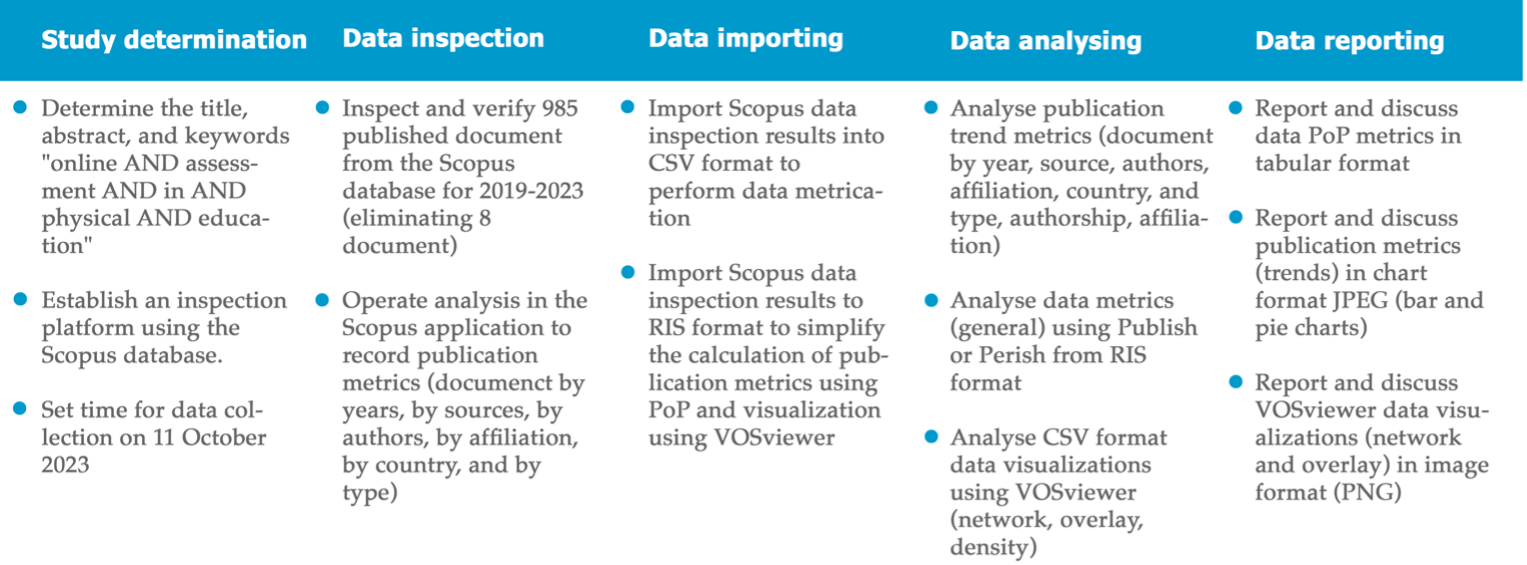
Figure 1: Research flow chart
Document by Years
The results of the Scopus database inspection during 2019-2023 found 985 articles (M+SD = 197+77.3). Respectively, 117 articles (11.88%) were published in 2019, followed by 2020 with 128 articles (12.99%), 2021 with 277 articles (28.12%), 2022 with 276 articles (28.02%), and 2023 with 183 articles (18.98%). Thus, the highest number of publications occurred in 2021, namely 28.12%. This data also explains that the number of articles in the four years in question is very significant, considering that, on average, there were 197 articles published each year (and 16.42 articles each month). This figure also correlates with the rise of the Covid-19 outbreak, which began to hit the world in 2019. Publication statistics were starting to increase along with online services for students' and university students' learning needs over almost the whole world, and started to decline in 2022 and 2023.

Figure 2: Document by years
Document per Years by Source
Overall, there were 143 publishers (sources) who published 985 articles from 159 authors (M+SD = 3.6+4.7). These 143 publishers published articles from the lowest range (one document) to 40 documents. In detail, 12 publishers published only one document, 75 publishers successfully published two documents, 22 publishers successfully published three documents, 14 publishers successfully published four documents, five publishers successfully published five documents, two publishers successfully published six documents, four publishers successfully published seven documents, two publishers successfully published two documents, and two publishers successfully published 10 documents. Meanwhile, publishers who independently succeeded in publishing articles were Lecture Notes in Networks and Systems (eight documents), Frontiers in Psychiatry (nine documents), American Journal of Physical Medicine and Rehabilitation (17 documents), BMC Medical Education (19 documents), BMJ Open (23 documents), Plos One (26 documents), and the highest was the publisher of the International Journal of Environmental Research and Public Health, which succeeded in publishing 40 documents during 2019-2023.
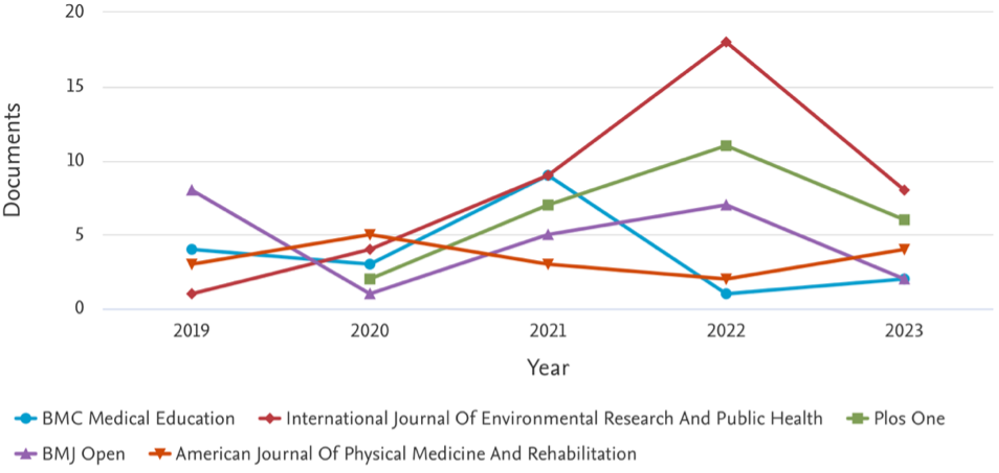 /center>
/center>
Document by Authors
One hundred fifty-nine authors contributed to the publication of 985 OA documents (M+SD = 2.1+0.5). Only two authors succeeded in contributing to OA publications, totalling six documents (0.61%), namely, Kim L. Bennell and Ranna S. Hinman. These two authors have also been involved in a collaborative publication entitled Technical Issues occur but are infrequent and have little impact on physiotherapist-delivered videoconferencing consultations for knee osteoarthritis: A descriptive study, published in the journal Musculoskeletal Science and Practice, 66, August 2023. Furthermore, three documents were successfully reported by 11 authors (1.12%). Two of them were by Gagnon et al. (2022), with an article entitled “Doctor of Physical Therapy Education in a Hybrid Learning Environment: A Case Report”, and, not to be left behind, Egerton et al. (2022) also published an article entitled, “Comparative Effect of Two Educational Videos on Self-efficacy and Kinesiophobia in People with Knee Osteoarthritis, an Online Randomised Controlled Trial”.

Document by Affiliation
The University of Melbourne dominated document publications with OA title words with 20 documents (2.03%) from other affiliates. Ranked below the University of Melbourne, The University of British Columbia managed to contribute 18 documents (1.83%), Monash University and The University of Sydney each contributed 16 documents (1.62%), the University of Toronto contributed 15 documents (1.52%), and the University of Alberta contributed 12 documents (1.22%). Harvard Medical School and The University of North Carolina at Chapel Hill School each contributed 11 documents (1.12%). Meanwhile, The Hong Kong Polytechnic University, the University of Oxford, and McMaster University each contributed 10 documents (1.02%).
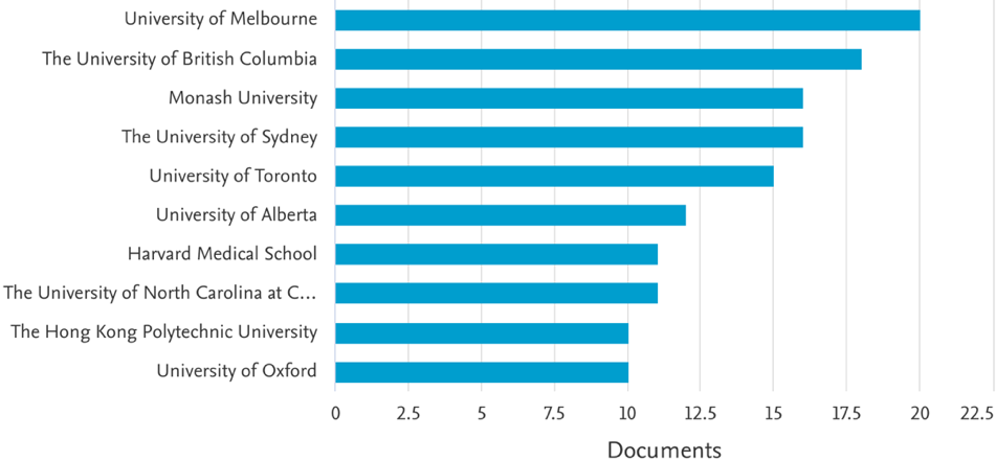
Figure 5: Document by affiliation
Document by Country
In the top 10 countries contributing to OA publications (M+SD = 14.6+31.9), Malaysia ranked last by contributing 25 documents (2.54%), followed by the Netherlands with 33 documents (3.35%), Germany with 36 documents (3.65%), Spain with 40 documents (4.06%), India with 43 documents (4.37%), China with 68 documents (6.90%), Canada with 74 documents (7.51%), Australia with 108 documents (10.96%), the United Kingdom with 142 documents (14.42%), and the highest was the United States with 254 documents (25.79%). Indonesia, Greece, Portugal, Russia, and Turkey successfully contributed to the publication of online assessments with 1.32% (13 documents)
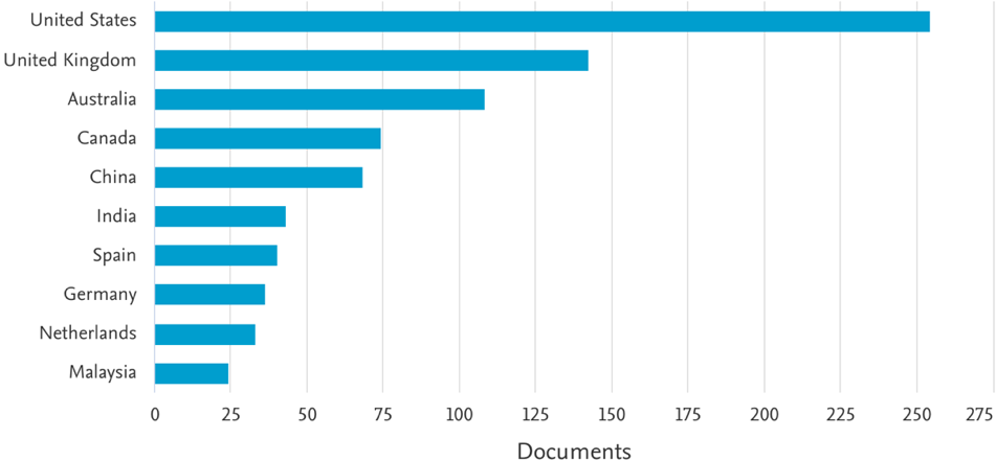
Figure 6: Document by country
Citation Trends
Over the period 2019-2023, the highest number of citations occurred in 2021, with a total of 2698 citations from 277 documents (average citations per document = 9.74). The highest number of citations (170) were in the article written by Chakraborty et al. (2021) entitled “Opinion of Students on Online Education during the Covid‐19 Pandemic”. The second highest number of citations was in 2020, with a total of 2147 citations from 128 documents (average citations per document = 16.77). The highest number of citations (156) was in the article written by Lin et al. (2020) entitled “Investigating Mediated Effects of Fear of Covid-19 and Covid-19 Misunderstanding in the Association between Problematic Social Media Use, Psychological Distress, and Insomnia”. The second-highest number of citations was in 2019, with 1666 citations from 117 published documents (average citations per document = 14.24). The highest number of citations (149) were in the article written by Morley et al. (2019) entitled “What is ‘Moral Distress’?” A narrative synthesis of the literature. Furthermore, there were 877 citations from 276 documents (average citations per document = 3.18). The highest number of citations (115) were in the article written by Papapanou et al. (2022) entitled “Medical Education Challenges and Innovations during Covid-19 Pandemic”. Finally, there were 125 citations from 187 published documents (average citations per document = 0.67) in 2023. The highest number of citations (16) is in the article written by Goodyear et al. (2023) entitled “The Influence of Online Physical Activity Interventions on Children and Young People’s Engagement with Physical Activity: A Systematic Review.”
Table 2: Trend Citation Based on unit of Analysis

If readers track it as a whole, the top number of citations (170) was in the article entitled “Opinion of Students on Online Education during the Covid-19 Pandemic” written by Chakraborty et al. (2021). Meanwhile, the article with the lowest citations (132) was entitled “Students' and Lecturers' Perspective on the Implementation of Online Learning in Dental Education due to SARS-CoV-2 (Covid-19): A Cross-Sectional Study”, written by Schlenz et al. (2020) (see Table 3). Other additional information, from 985 documents, is there were 28.83% of articles that had not received citations (0), respectively, in 2019 = 0.81% (8 documents), in 2020 = 1.02% (10 documents), in 2021 = 5.28% (52 documents), in 2022 = 8.83% (87 documents) and in 2023 = 12.89% (127 documents).
Table 3: Five Top Citations
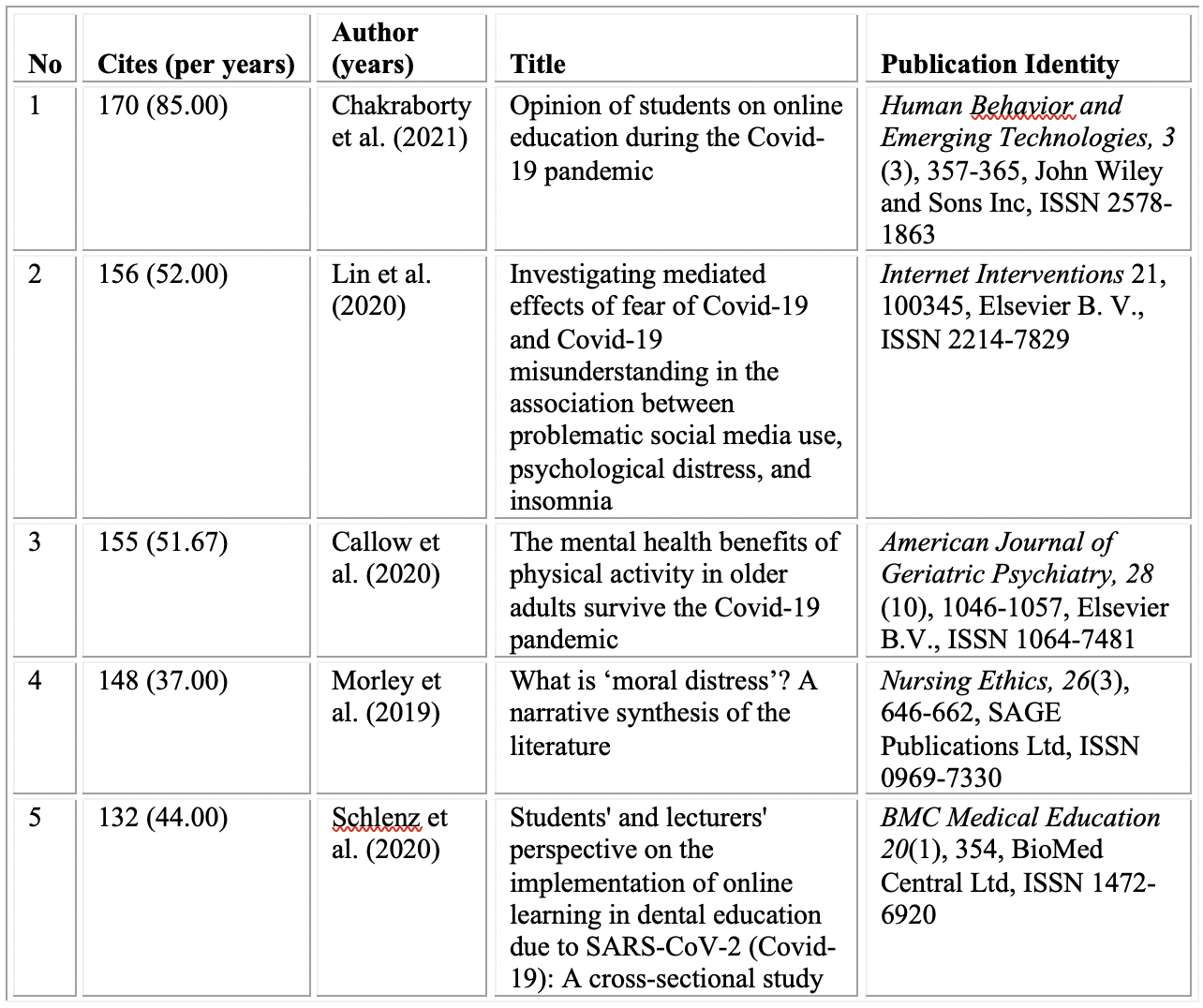
Keyword Trends
Keyword trends were analysed using a unit of analysis of all keywords with a full counting method and a minimum number of occurrences of a keyword of 10, resulting in 31 meeting the threshold of the 7,399 keywords. In choosing a number of terms, the keywords with the greatest total link strength were selected with 391 keywords. The results of the analysis found that 391 items were selected, forming five clusters, 37,045 links, and 165,811 total strong links (see Table 4). Next, the 10 keywords with the highest occurrences in a row were, 1) human (666 with a total link strength of 13,411), 2) humans (500 with a total link strength = 10,429), 3) article (499 with a total link strength = 11,208), 4) male (415 with total link strength = 9,493), 5) adult (393 with a total link strength = 9,160), 6) controlled study (268 with a total link strength = 6,342), 7) questionnaire (256 with a total link strength = 6,054 ), 8) education (235 with total link strength = 4,693), 9) major clinical study (215 with a total link strength = 5,126), and 10) Covid-19 (214 with total link strength = 3,983).

Keywords that are relevant to this research include physical activity, which ranked 11th (194 occurrences; 4685 total link strength); online assessment, which ranked 13th (162 occurrences; 3797 total link strength); physical education formed only 54 occurrences with a total link strength of 606, physical performance formed only 19 occurrences with a total link strength of 469, physical education and training formed 14 occurrences with a total link strength of 276), and online teaching was in last place, namely 391, and, therefore, formed only 10 occurrences with a total link strength of 68 . The VOSviewer visualisation results also prove that OA keywords in PE are still very limited (see Figure 7-right), so they still have the potential to be explored by future researchers. Online assessment is mostly published in documents in the health sector. This result was also confirmed by the discovery of the highest number of published documents (articles) in the subject area "Medicine" with 550 documents. It means that documents with the subject area "Medicine" accounted for 34.4% of articles. This figure is 19.3% higher than the subject area "Social Science," which is right below it with 15.2%.
Table 4: Cluster of 391 Items

In the choose threshold display, the minimum number of occurrences of a term used was 10, so only 974 met the threshold of 26,975 terms. Next, in choosing a number of terms, out of 974 terms, the most relevant terms selected was at 584 (60% most relevant terms). The results of the analysis found that 584 items were selected, forming six clusters, 50,920 links, and 37,6982 total strong links (see Table 5). Next, the 10 terms with the highest occurrences in a row were, 1) students (1418 with relevance value = 0.76), 2) intervention (630 with relevance value = 0.44), 3) course (351 with relevance value = 0.95), 4) physical activity (300 with relevance value = 0.48), 5) skill (272 with relevance value = 0.57), 6) teaching (264 with relevance value = 1.22), 7) university (252 with relevance value = 0.72), 8) child (249 with relevance value = 0.62), 9) teacher (244 with relevance value = 0.87), and 10) system (243 with relevance value = 0.76). Meanwhile, of the 584 terms (4.28%), the term included in the lowest occurrences (10), was one physical term, namely "physical consultation."/p>

Not much different from keyword visualisation, even though we have visualised more terms through title and abstract, it turned out that the term "online assessment" was still limited by only forming 46 occurrences and 0.80 relevance so it was not formed in the VOSviewer visualisation (cluster 1). The "online assessment" network was only formed around the term "students and systems". Furthermore, the term "physical education" only formed 111 occurrences and 1.03 relevance. The "physical education" network only formed around the terms "courses, system, lesson, teaching, teacher, technology, student, challenge, university, and sport". In the VOSviewer visualisation, both network and overlay (see Figure 8), the two terms searched (OA and PE), apart from having a low label (item) load (so they were not readable in the VOSviewer visualisation), these two terms also did not have a network. Thus, future investigations into OA in PE have great potential to support teachers in making learning effective and efficient by maximising technology.
Table 5: Cluster of 584 Items
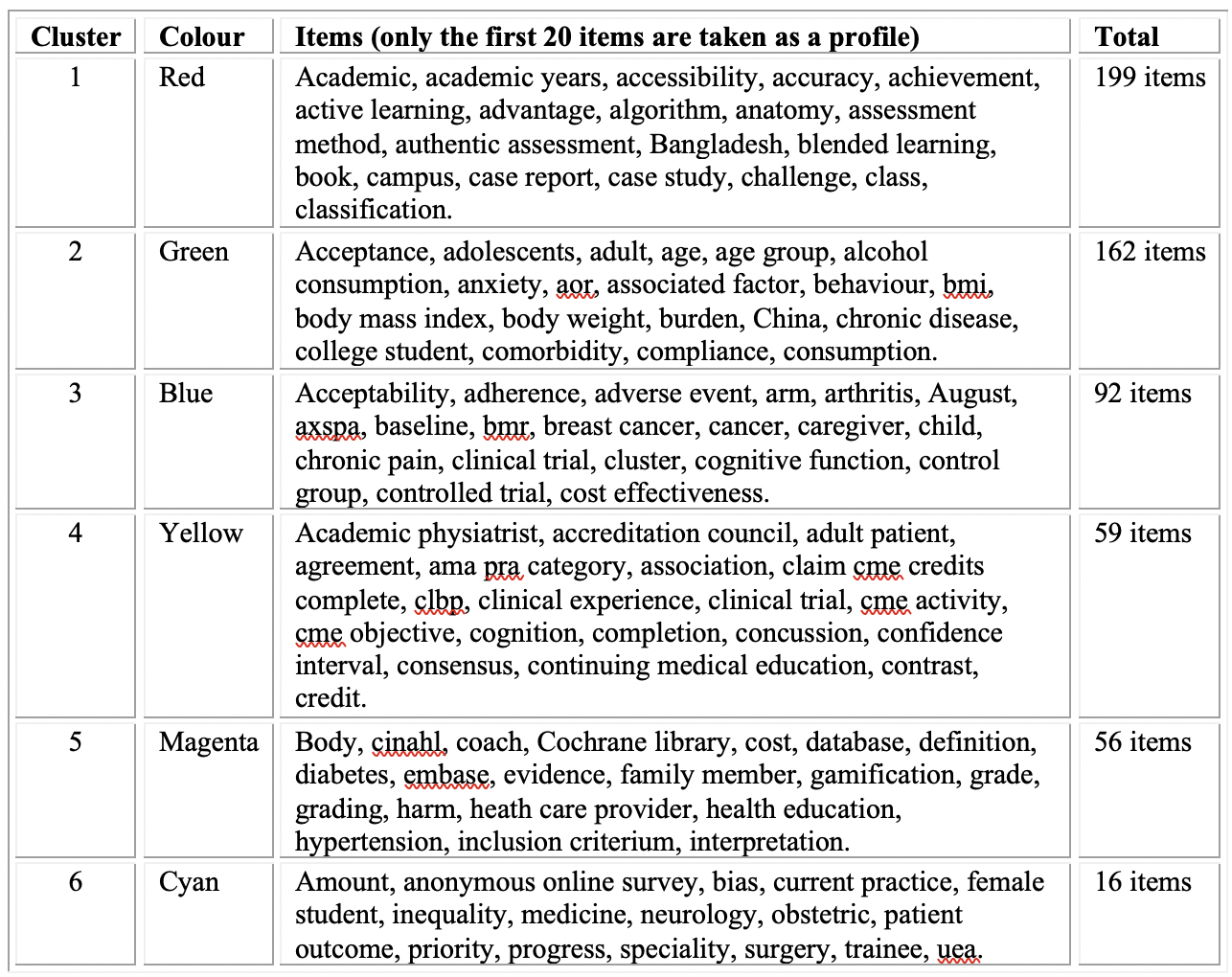
The peak of OA publications in PE occurred in 2021 (277 documents) and experienced a decrease of 0.10% in 2022 and a decrease of 9.04% in 2023. One of the reasons for this decreasing trend was the start of the recovery from the Covid-19 pandemic, so face-to-face learning started to be held with certain terms and conditions. VOSviewer visualisation results show that the 985 article titles, abstracts and keywords "online AND assessment AND in AND physical AND education", during 2019-2023, were still very limited. This conclusion was confirmed from the three VOSviewer visualisations that show the online assessment title words and physical education title words had a low item load. Hence, the labels were small and not visible. Some research that confirmed the examination of OA in PE was presented by Backman et al. (2023) in an article entitled “The Assessment of Final Year Projects in Physical Education Pre-Service Teacher Education: From a Face-to-Face Assessment to an Online Assessment”. Also in an article entitled “Needs Assessment QR Code Combination with Google Form for Online Cognitive Assessment”, by Firmansyah et al. (2021). Other relevant studies discussed only the online implementation of PE (Jeong & So, 2020; Wang et al., 2023; Yu & Jee, 2021).
A number of publications on bibliometric studies on OA have been carried out previous to this by several researchers from various countries. The studies referred to include online formative assessment in higher education in Russia (Sudakova et al., 2022), online assessment in higher education in Germany (Heil & Ifenthaler, 2023), applications articles on online assessment process in Turkey (Yıldız & Çakmak, 2023), peer assessment in online language courses in China (Y. Lin & Yu, 2023), and online education in sports in the Republic of Korea (Zhou, 2023). The bibliometric study on online assessment above has been discussed in at least four articles. Unfortunately, it did not address the subject of PE. Meanwhile, another bibliometric study by Zhou (2023) discussed PE, but only with regard to PE online learning, not specifically OA. This means that the results of this study can fill the gaps in previous studies, while providing a new perspective that investigating OA is still a promising future research need. This is not only due to the limited number of studies on OA but also to the need for more clinical investigation on the use of OA in PE, which is essential for strategic recommendations to teachers integrating technology in supporting decisions regarding the development of credible student learning outcomes.
As the Covid-19 period ends, teachers will organise face-to-face PE because they miss interactive relationships with their students (Kim et al., 2021) and have more effective ‘control’ over the integration of various educational objectives during students' movement experiences. During the PE onsite service situation, teachers still need assessment measures to measure the achievement of the learning objectives that they have formulated in their lesson plans. Physical education teachers still need the integration of OA methods, even in face-to-face learning. According to Ithindi & Shikalepo (2022), OA helps teachers improve objective and credible assessment processes on student learning performance. Apart from being environmentally friendly, OA also facilitates students getting timely (time-saving) and detailed feedback and makes it easier for them to access information about their performance (Lee et al., 2022; Yıldız & Çakmak, 2023). Thus, the need to develop teachers' online literacy needs to be considered, not only for the online learning period but also to support teachers' teaching performance in offline learning (Tian et al., 2023). Utilising technology in assessments must become an integral part of PE (held online or offline), as has been practiced by Everhart & McKethan (2008), who used an online assessment system to support the programme report process long before Covid-19 became a pandemic.
Still related to OA, readers can also consider the results of recent studies that have successfully diagnosed several OA used to evaluate academic performance, including tests, online exams, online presentations, online quizzes, case studies and report submissions. Qualitative empirical evidence shows that online exams, online quizzes and submission of reports have a significant impact on academic performance (González-Rivera et al., 2023; Thathsarani et al., 2023). Additionally, from a comprehensive literature review, Huber et al. (2023) succeeded in identifying five main design considerations for using OA, namely, that the assessment must: 1) ensure academic integrity; 2) enable the provision of quality feedback; 3) support a positive learning experience for students; 4) ensure the integrity of student information; and 5) ensure all students have an equal opportunity to complete the assessment successfully. Some problems that also concern teachers in using OA are that OA gives students the opportunity to use unfair methods, does not create a feeling of mastery of subject knowledge after the exam and creates concerns about using digital assistance before the exam (Nagar & Pradhan, 2022), so that if at least some of these problems are not resolved, teachers will have difficulty guaranteeing quality OA for their students (Bouhidel, 2022). This phenomenon could also become a research topic for OA in PE in the future.
With visualisation via title and abstract, it turns out that the term "online assessment" was still limited to forming only 46 occurrences and 0.80 relevance. Furthermore, the term "physical education" formed only 111 occurrences and 1.03 relevance. These two terms were also proven to have a small item load, so they were not visualised in the VOSviewer output and also did not have networking. This means this study has proven that the results of online assessment inspections in physical education still have potential for future research. The limitation of this research is that it used only the keyword online assessment in PE, so it did not accommodate other terms that had the same synonym as online assessment, such as technology assessment, digital assessment and others. Hence, investigations into these terms should also be explored.
The need to develop various skills to prepare students to survive in the future has varied and is also changing rapidly. This variation and speed are also ideally directly proportional to the "speed" of teachers' accessibility to various instruments for assessing and making decisions on student learning outcomes, as well as the speed of accessibility for students and parents to determine the progress of their children's learning outcomes. For this reason, the study of OA development in PE is a strategic and crucial action. One of the objectives of future research that can be tested is to place online various instruments for assessing student learning outcomes, from the cognitive, affective and psychomotor aspects, in order to make it easier for teachers in their operation, accessibility, analysis and, of course, decisions on the development of student learning outcomes.
Adkins, M., Wajciechowski, M.R., & Scantling, E. (2013). The mystery behind the code: Differentiated instruction with quick response codes in secondary physical education. Strategies: A Journal for Physical and Sport Educators, 26(6), 17-22. https://doi.org/10.1080/08924562.2013.839432
Backman, E., Quennerstedt, M., Tolgfors, B., & Nyberg, G. (2023). Peer assessment in physical education teacher education – A complex process making social and physical capital visible. Curriculum Studies in Health and Physical Education, 1-15. https://doi.org/10.1080/25742981.2023.2256327
Baker, E.L. (2012). Assessment in learning. In N.M. Seel (Ed.), Encyclopedia of the sciences of learning (pp. 316–321). Springer US. https://doi.org/10.1007/978-1-4419-1428-6_22
Blegur, J., Ma’mun, A., Mahendra, A., Mahardika, I.M.S., & Tlonaen, Z.A. (2023). Bibliometric analysis of micro-teaching model research trends in 2013-2023. Journal of Innovation in Educational and Cultural Research, 4(3), 523-533. https://doi.org/10.46843/jiecr.v4i3.782
Blegur, J., Rajagukguk, C.P.M., Sjioen, A.E., & Souisa, M. (2023). Innovation of analytical thinking skills instrument for throwing and catching game activity for elementary school students. International Journal of Instruction, 16(1), 723-740. https://doi.org/10.29333/iji.2023.16140a
Bouhidel, H. (2022). Exploring teachers’ perceptions toward online assessment: Perspectives and challenges. Afak for Sciences Journal, 7(3), 112-126.
Chakraborty, P., Mittal, P., Gupta, M.S., Yadav, S., & Arora, A. (2021). Opinion of students on online education during the Covid‐19 pandemic. Human Behavior and Emerging Technologies, 3(3), 357-365. https://doi.org/10.1002/hbe2.240
Donthu, N., Kumar, S., Mukherjee, D., Pandey, N., & Lim, W.M. (2021). How to conduct a bibliometric analysis: An overview and guidelines. Journal of Business Research, 133, 285-296. https://doi.org/10.1016/j.jbusres.2021.04.070
Egerton, T., Bennell, K.L., McManus, F., Lamb, K.E., & Hinman, R.S. (2022). Comparative effect of two educational videos on self-efficacy and kinesiophobia in people with knee osteoarthritis: An online randomised controlled trial. Osteoarthritis and Cartilage, 30(10), 1398-1410. https://doi.org/10.1016/j.joca.2022.05.010
Everhart, B., & McKethan, R. (2008). Using an online assessment system to support the program report process in physical education teacher education. Journal of Physical Education, Recreation & Dance, 79(4), 41-45. https://doi.org/10.1080/07303084.2008.10598163
Firmansyah, G., Dwi Rahayu, E., Hariyanto, D., Irwansyah, Setyawan, T., & Muhamad Aris, T. (2021). Needs assessment QR code combination with google form for online cognitive assessment. Journal of Physics: Conference Series, 1779(1), 012015. https://doi.org/10.1088/1742-6596/1779/1/012015
Fitriady, G., Alfarizi, M., & Saputra, S.A. (2022). Optimization of movement skills assessment in physical education learning using online self and peer assessment. Journal of Science and Education (JSE), 3(2), 159-164. https://doi.org/10.56003/jse.v3i2.168
Fitriady, G., Nurrochmah, S., Yudasmara, D.S., & Salamuddin, N. (2022). Alternative assessment for movement skills in physical education: The effectiveness of online self and peer assessment. In Y.N. Hanief, R. Kurniawan, T.D. Tama, D. Mawarni, A. Hapsari, N. Nandini, E. Astutik, & M.V. Humairo (Eds.), Proceedings of the International Conference on Sports Science and Health (ICSSH 2022) (pp. 393-398). Atlantis Press International BV. https://doi.org/10.2991/978-94-6463-072-5_40
Gagnon, K., Bachman, T., Beuning, B., Koppenhaver, S., Unverzagt, C., Feda, J., Gantt, C., & Young, B. (2022). Doctor of physical therapy education in a hybrid learning environment: A case report. Physical Therapy, 102(8), pzac074. https://doi.org/10.1093/ptj/pzac074
González-Rivera, M-D., Campos-Izquierdo, A., Hall, N.D., & Villalba-Pérez, A.I. (2023). Planning and assessment practices among Spanish physical education teachers according to experience and teaching level. European Physical Education Review, 29(3), 438-454. https://doi.org/10.1177/1356336X231158916
Goodyear, V.A., Skinner, B., McKeever, J., & Griffiths, M. (2023). The influence of online physical activity interventions on children and young people’s engagement with physical activity: A systematic review. Physical Education and Sport Pedagogy, 28(1), 94-108. https://doi.org/10.1080/17408989.2021.1953459
Hanief, Y.N. (2021). Bibliometric analysis of Jurnal SPORTIF: Jurnal penelitian pembelajaran. Jurnal SPORTIF: Jurnal Penelitian Pembelajaran, 7(1), 51-70. https://doi.org/10.29407/js_unpgri.v7i1.15680
Heil, J., & Ifenthaler, D. (2023). Online assessment in higher education: A systematic review. Online Learning Journal, 27(1), 187-218. https://doi.org/10.24059/olj.v27i1.3398
Huber, E., Harris, L., Wright, S., White, A., Raduescu, C., Zeivots, S., Cram, A., & Brodzeli, A. (2023). Towards a framework for designing and evaluating online assessments in business education. Assessment and Evaluation in Higher Education, 1-15. https://doi.org/10.1080/02602938.2023.2183487
Ithindi, S.N., & Shikalepo, E.E. (2022). Enhancing the quality of online assessment in higher education. International Journal of Social Science and Human Research, 5(7), 3350-3353. https://doi.org/10.47191/ijsshr/v5-i7-77
Jeong, H.C., & So, W.Y. (2020). Difficulties of online physical education classes in middle and high school and an efficient operation plan to address them. International Journal of Environmental Research and Public Health, 17(19), 1-13. https://doi.org/10.3390/ijerph17197279
Joshi, A., Virk, A., Saiyad, S., Mahajan, R., & Singh, T. (2020). Online assessment: Concept and applications. Journal of Research in Medical Education & Ethics, 10(2), 49. https://doi.org/10.5958/2231-6728.2020.00015.3
Kánová, K., & Pišútová, K. (2022). Theory and practice of online assessment at Comenius University. International Scientific Days, 505-514. https://doi.org/10.15414/isd2022.s5-1.04
Kim, M., Yu, H., Park, C.W., Ha, T., & Baek, J.H. (2021). Physical education teachers’ online teaching experiences and perceptions during the covid-19 pandemic. Journal of Physical Education and Sport, 21, 2049–2056. https://doi.org/10.7752/jpes.2021.s3261
Lee, V.W.Y., Lam, P.L. C., Lo, J.T.S., Lee, J.L.F., & Li, J.T.S. (2022). Rethinking online assessment from university students’ perspective in Covid-19 pandemic. Cogent Education, 9(1), 2082079. https://doi.org/10.1080/2331186X.2022.2082079
Li, W., & Zhao, Y. (2015). Bibliometric analysis of global environmental assessment research in a 20-year period. Environmental Impact Assessment Review, 50, 158-166. https://doi.org/10.1016/j.eiar.2014.09.012
Lin, C.-Y., Broström, A., Griffiths, M. D., & Pakpour, A. H. (2020). Investigating mediated effects of fear of Covid-19 and Covid-19 misunderstanding in the association between problematic social media use, psychological distress, and insomnia. Internet Interventions, 21, 100345. https://doi.org/10.1016/j.invent.2020.100345
Lin, Y., & Yu, Z. (2023). A bibliometric analysis of peer assessment in online language courses. Languages, 8(1), 47. https://doi.org/10.3390/languages8010047
Marmoah, S., Gestiardi, R., Sarwanto, S., Chumdari, C., & Maryani, I. (2022). A bibliometric analysis of collaboration skills in education (2019-2021). Journal of Education and Learning (EduLearn), 16(4), 542–551. https://doi.org/10.11591/edulearn.v16i4.20337
Mejia, C., Wu, M., Zhang, Y., & Kajikawa, Y. (2021). Exploring topics in bibliometric research through citation networks and semantic analysis. Frontiers in Research Metrics and Analytics, 6, 742311. https://doi.org/10.3389/frma.2021.742311
Morley, G., Ives, J., Bradbury-Jones, C., & Irvine, F. (2019). What is ‘moral distress’? A narrative synthesis of the literature. Nursing Ethics, 26(3), 646-662. https://doi.org/10.1177/0969733017724354
Nagar, S., & Pradhan, P. (2022). Higher education student’s outlook towards online assessment: A multivariate analysis. Seybold Report, 17(6), 112-122. https://doi.org/10.5281/zenodo.6707949
No, J.G. (2022). Experiences of physical education teachers on students’ assessment in times of Covid-19 pandemic. Asian Journal of Education and Social Studies, 31(2), 10-21. https://doi.org/10.9734/ajess/2022/v31i230741
Papapanou, M., Routsi, E., Tsamakis, K., Fotis, L., Marinos, G., Lidoriki, I., Karamanou, M., Papaioannou, T.G., Tsiptsios, D., Smyrnis, N., Rizos, E., & Schizas, D. (2022). Medical education challenges and innovations during Covid-19 pandemic. Postgraduate Medical Journal, 98(1159), 321–327. https://doi.org/10.1136/postgradmedj-2021-140032
Perdima, F.E., Suwarni, & Gazali, N. (2022). Educational technology in physical education learning: A bibliometric analysis using Scopus database. SPORT TK-Revista EuroAmericana de Ciencias Del Deporte, 11(2), 14. https://doi.org/10.6018/sportk.517091
Puspita, A.D., Maryani, I., & Sukma, H.H. (2023). Problem-based science learning in elementary schools: A bibliometric analysis. Journal of Education and Learning (EduLearn), 17(2), 285-293. https://doi.org/10.11591/edulearn.v17i2.20856
Schlenz, M.A., Schmidt, A., Wöstmann, B., Krämer, N., & Schulz-Weidner, N. (2020). Students’ and lecturers’ perspective on the implementation of online learning in dental education due to SARS-CoV-2 (Covid-19): A cross-sectional study. BMC Medical Education, 20(1), 354. https://doi.org/10.1186/s12909-020-02266-3
Sinag, J.M.D.P. (2023). Experiences of physical education teachers in District of Dinalupihan on students’ performance assessment in times of covid-19 pandemic. Indonesian Journal of Research in Physical Education, 1(1), 15–29. http://journal-fik.um.ac.id/index.php/ijrpesh/article/view/3
Sudakova, N.E., Savina, T.N., Masalimova, A.R., Mikhaylovsky, M.N., Karandeeva, L.G., & Zhdanov, S.P. (2022). Online formative assessment in higher education: Bibliometric analysis. Education Sciences, 12(3), 209. https://doi.org/10.3390/educsci12030209
Thathsarani, H., Ariyananda, D.K., Jayakody, C., Manoharan, K., Munasinghe, A.A.S.N., & Rathnayake, N. (2023). How successful the online assessment techniques in distance learning have been, in contributing to academic achievements of management undergraduates? Education and Information Technologies, 1-25. https://doi.org/10.1007/s10639-023-11715-7
Tian, H., Sun, M., Liu, H., & Li, F. (2023). Developing an assessment of online learning literacy for physical education teachers (OLLPET) in China. Research Square, 1-23. https://doi.org/10.21203/rs.3.rs-2873136/v1
Tolgfors, B., Quennerstedt, M., Backman, E., & Nyberg, G. (2022). Enacting assessment for learning in the induction phase of physical education teaching. European Physical Education Review, 28(2), 534-551. https://doi.org/10.1177/1356336X211056208
van Eck, N.J., & Waltman, L. (2010). Software survey: VOSviewer, a computer program for bibliometric mapping. Scientometrics, 84(2), 523-538. https://doi.org/10.1007/s11192-009-0146-3
van Eck, N.J, & Waltman, L. (2023). VOSviewer manual: Manual for VOSviewer version 1.6.19. Universiteit Leiden.
Walters, W., MacLaughlin, V., & Deakin, A. (2023). Perspectives and reflections on assessment in physical education: A narrative inquiry of a pre-service, in-service and physical education teacher educator. Curriculum Studies in Health and Physical Education, 14(1), 73-91. https://doi.org/10.1080/25742981.2022.2053334
Wang, C., Omar Dev, R.D., Geok Soh, K., Nasirudddin, N.J.M., Yuan, Y., & Ji, X. (2023). Blended learning in physical education: A systematic review. Frontiers in Public Health, 11, 1073423. https://doi.org/10.3389/fpubh.2023.1073423
Yıldız, G., & Çakmak, E.K. (2023). Bibliometric analysis of applications articles on online assessment process. International Journal of Educational Research Review, 8(4), 788-802. https://doi.org/10.24331/ijere.1316582
Yu, J., & Jee, Y. (2021). Analysis of online classes in physical education during the Covid-19 pandemic. Education Sciences, 11(1), 1-14. https://doi.org/10.3390/EDUCSCI11010003
Zhou, T. (2023). Bibliometric analysis and visualization of online education in sports. Cogent Social Sciences, 9(1), 2167625. https://doi.org/10.1080/23311886.2023.2167625
Author Notes
https://orcid.org/0000-0002-5932-198X
https://orcid.org/0000-0002-0162-0047
https://orcid.org/0009-0000-9693-8842
Jusuf Blegur is an associate professor and was a lecturer in the Physical Education, Health, and Recreation Study Program, Faculty of Teacher Training and Education, Universitas Kristen Artha Wacana. Jusuf completed his bachelor’s degree in education at Universitas Kristen Artha Wacana (2011), master’s degree in education at Universitas Negeri Surabaya (2013), and since 2022 has been registered as a doctoral candidate in the sports education at Universitas Pendidikan Indonesia. His research focuses on physical education learning, lesson planning, learning strategies, learning models, and micro-teaching. Email: jusufblegur@ukaw.ac.id
Fegie Rizkia Mulyana is an assistant professor in the Physical Education Study Program, Faculty of Teacher Training and Education, Universitas Siliwangi. Fegie completed a bachelor’s degree in education at Universitas Siliwangi (2012), a master's degree in education at Universitas Negeri Jakarta (2015), and since 2022, has been registered as a candidate for a Doctor of Sports Education at the Universitas Pendidikan Indonesia. His research focuses on physical education, psychosocial learning, and sports psychology. Email: mtaufikhidayat637@gmail.com, fegierizkiamulyana@unsil.ac.id
Andi Saparia is an associate professor in the Physical Education Study Program Faculty of Teacher Training and Education, Universitas Tadulako. Andi completed a bachelor's degree in education in 2004 and a master's degree in education in 2011, respectively, at Universitas Negeri Makassar and a doctorate at Universitas Negeri Jakarta in 2020. His research focuses on sports education, education management, and recreation education. Email: mtaufikhidayat637@gmail.com, andi_saparia@untad.ac.id
Cite as: Blegur, J., Mulyana, F.R., & Saparia, A. (2024). Publication trends of online assessment in physical education. Journal of Learning for Development, 11(2), 361-380.